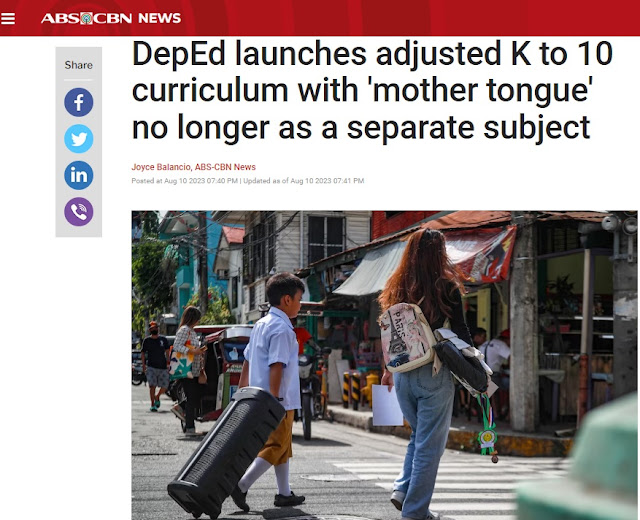DepEd Has a New Curriculum
After more than ten years, the Department of Education in the Philippines has now taken steps to revised its ill-advised K plus 12 curriculum. The new curriculum, called MATATAG K to 10 curriculum addresses some of the issues I raised in the first post on this blog.
 |
| Above copied from ABS-CBN News |
As a summary, these are the changes according to ABS-CBN News:
In the present system, there are the seven identified foundational skills or learning areas for students:
- mother tongue
- Filipino
- English
- Mathematics
- Araling Panlipunan
- MAPEH
- Edukasyon sa Pagpapakatao
Under the adjusted K to 10 curriculum, learning areas are reduced to only five:
- Language
- Reading and Literacy
- Mathematics
- Makabansa
- GMRC (Good Manners and Right Conduct)
There are likewise suggestions that the spiral approach in teaching math and sciences in grades 7 to 10 would be removed. The K plus 12 curriculum was clearly a wasteful experiment in the past ten years. It led to no improvement in basic education. What remains to be seen is whether the Department of Education finally realizes that the only way to improve education is by providing adequate resources.
This blog has been silent for awhile, but it maybe helpful to go back and see what started this blog. Here is one of the first posts on this blog:
The proposed K plus 12 curriculum has various components. It is useful to look at each component in deciding whether it helps address the pressing problems Philippine basic education presently faces:
(1) Kindergarten: This addresses the problems. Early childhood learning when done properly does provide a head start for elementary schools. Kindergarten prepares the child emotionally, physically and mentally for grade school.
(2) No formal subject of science in K to Grade II: This is a waste of a great opportunity. Science education in early childhood is cheap. It does not require elaborate laboratories or equipment. Young children, in addition, are naturally inquisitive and the years of kinder to grade II are excellent for introduction of basic scientific curiosity and methods. Only having science as a formal subject can ensure that science will indeed be covered.
(3) Use of mother tongue as medium of instruction: This is very expensive. It requires competent teachers who can teach math and science using the mother tongue. There is no objection that the mother tongue must be taught as a subject in elementary schools since this allows a smoother transition from home to school. The question of what medium should be used in instruction is separate. One medium of instruction can unite the nation. English is the best option since course materials especially from the internet are usually in English. In this respect, Singapore is a good example to follow.
(4) Spiral curriculum: This type of teaching is highly applicable to elementary schools where both science and math are still treated as general approaches. In high school, both math and science diverge into separate disciplines. A spiral curriculum in high school will require teachers with knowledge in all these areas at a sufficient level. These required teachers are not going to be available in numbers so this program will be poorly implemented. A layered curriculum, on the other hand, is easier to implement – biology is taught in one year, chemistry in the next, physics is usually the last. In this manner, a high school can operate with a chemistry teacher, a physics teacher and a biology teacher, and each one need not be a master of all three disciplines.
(5) Discovery-based learning: This type of learning requires longer hours and fails without sufficient guidance (see “An Analysis of the Failure of Electronic Media and Discovery Based Learning”,Clark, et al. (2009)
http://www.cogtech.usc.edu/publications/clark_etal_2009_analysis_of_the_failure_of_electronic_media.pdf). The ideal is a mix between traditional and inquiry based methods. This is usually achieved in the sciences by having separate lecture and laboratory components. Guidance is provided during lectures and students work on their own or as a group in the laboratory.
(6) Last but not the least (in fact, this point is crucial), the proposed K plus 12 curriculum also involves short school hours. This seems to be an attempt to enable multiple shifts in the schools. This goes against decongesting the curriculum. It likewise does not make it worthwhile for schoolchildren especially those who have to travel far to attend school. This also opens opportunities for child labor as well as greater environmental (outside of school) influences on children education. Elementary schools in the US are full day so that students do have time to cover the material and, at the same time, it allows parents to work and be more productive. A full day in school means less television, less video games, less time on the streets, and less other activities that do not contribute to a sound education of the young.
Comments
Post a Comment